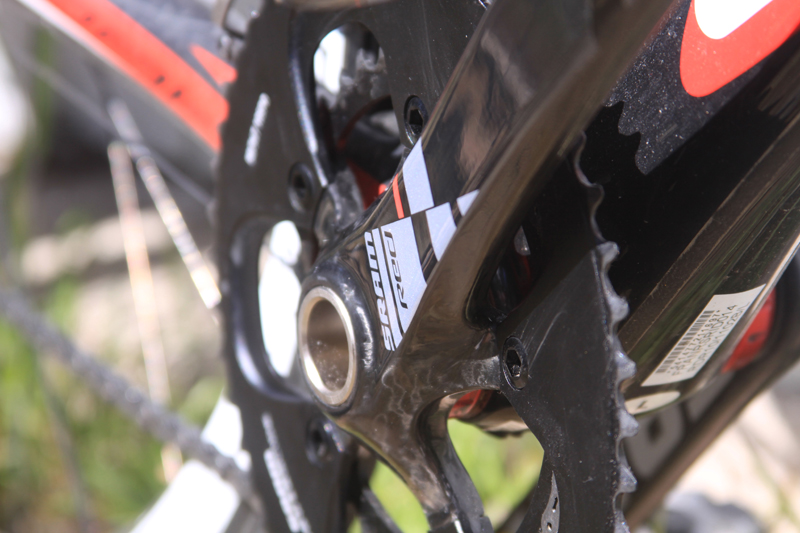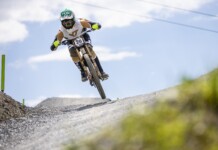[Note: A variation of Deterline’s crank length discussion first appeared as The Crank Length Debate: Coming Full Circle in the November 2008 issue of Triathlete Magazine.]
A few years ago I was building up a new TT/tri bike and asked friend and colleague John Cobb, famed aerodynamics and biomechanics expert, what length cranks to use. John has been a well respected fixture in the world of triathlon for decades, and in some road cycling circles, especially those who followed LeMond and Armstrong’s early visits to the wind tunnel, and Cobb’s design activities for companies like Rudy Project.

When I had first gotten into cycling, I was told that at my height (6’3”) I should be using 180mm cranks on my TT and mountain bikes, and maybe 177.5mm cranks on my road bike. It was all about having as big a lever as possible for climbing hills and turning over big gears on the flats. That thinking still prevailed in some circles. However, Cobb had always been a maverick, so I shouldn’t have been as surprised as I was by his response:
“I used to be a big believer in long crank arms, but now I’m going in a different direction. I’m convinced that crank length and pedal rate (i.e. cadence) should be more directly related to one’s natural running cadence and stride length than anything else. Every muscle has a natural contraction rate that will yield maximum efficiency. The game is to keep the muscle in its most efficient extension range and at its most efficient rate of rotation.”
John McDaniel holds a PhD in Exercise Physiology, and is an elite amateur road racer and triathlete. He has also worked as a research associate of Dr. Jim Martin, whose exercise physiology lab at the University of Utah is renowned. McDaniel added some insight to Cobb’s observations:
“Every muscle does two things for which an athlete should strive to determine optimal performance parameters: one is the contraction-relaxation rate (the rate at which the muscle will contract, perform work, then relax), and shortening velocity (the speed at which the muscle is working [a muscle shortens as velocity increases]). These two tasks determine maximum power and maximum efficiency.
“By varying pedal rate and crank length we can adapt conditions to the muscular system so that it operates closer to its maximum efficiency or power. Our goal is to do both! It is interesting to note, however, that the parameters in which max power is produced are often not the same as those that produce max efficiency. This is obvious in cycling where max power is usually produced around 120-130 pedal rpm’s (rotations per minute), yet max efficiency is reached at around 60-70 rpm’s.”
When I subsequently brought up the issue of crank length with Ironman champ and über-biker Chris Lieto, he informed me that internationally renowned Exercise Physiologist and coach Max Testa had made the same suggestion – that Lieto consider transitioning to shorter cranks to improve efficiency. But Lieto confided that he had been reluctant to make the switch, since he was comfortable on 175mm cranks, the same length he used on his road bike, and hadn’t wanted to mess with what he felt was “dialed in”.
Cobb went on to explain what got him moving in his new direction of thought in the first place:
“My initial motivation for experimenting with shorter cranks was to get riders lower on their bikes by rotating them forward and down, without their legs hitting their rib cage, and without restricting their breathing. But first, I had to determine that shorter cranks and the potentially lower overall seat heights new geometries could eventually afford) would not adversely affect power output or efficiency. That led me to Professor Jim Martin at the University of Utah.
“Martin conducted a study using 60 racers of all skill levels. He would vary crank length in 15mm increments, both longer and shorter. His findings showed that there was no power difference from one length to another, but that oxygen uptake was always better with shorter cranks.
“Subsequently I worked with a rider who is 6’5″, bringing his crank length down to 165mm’s over three months. He’s gained 65 watts of power.”
McDaniel elaborates:
“During one particular study, Martin and I recorded athletes’ oxygen consumption while cycling on a stationary bike in the lab. We used crank lengths of 145, 170 and 195 mm; pedaling rates of 40, 60, 80 and 100 rpm’s; and intensity levels of 30, 60 and 90% of lactate threshold.
“We found that the power produced (i.e. force applied to move the pedals) during exertion accounted for 95% of oxygen consumption (V02). Changes in crank length and pedal rate had the capacity to alter oxygen consumption or efficiency by about 3%.
“Furthermore, this study demonstrated that the body requires more oxygen as pedal speed (speed of the pedal along its axis of travel – NOT cadence) increases. So, for any given pedal rate (cadence), pedal speed will therefore be slower with shorter cranks, resulting in a decreased oxygen requirement.
“Let me emphasize, however, that we determined modest changes in oxygen consumption across the large variations in crank length (145 to 190 mm) that we implemented. So switching from 175 to 172.5 mm would likely have little measureable or even undetectable benefit. The main point is that you would be safe switching to shorter cranks for aerodynamic reasons, as proposed by Cobb, without fear of decreasing efficiency. In fact, research implies your efficiency would increase somewhat.”
Since I’m about 6’3” with a common proportional inseam for North Americans, Cobb suggested that for starters I shouldn’t go any longer than 170mm, and that I may even want to try 165’s. Then Cobb introduced what at first seemed a contradiction:
“My own continued research and experience supported Martin and his associates’ findings. But there was a recurring theme I was noting in my work with athletes: in order for shorter cranks to ‘feel right’ to my riders, they had to start turning bigger gears.”
Since I’m predominantly a roadie who has been using a 53-tooth chainring with 175-180mm crank arms, Cobb offered that I might want to mount a 54 or 55-tooth chainring if I moved to shorter cranks.
This didn’t make sense to me – or McDaniel – initially, as it seemed to contradict the whole leverage component of the discussion. A shorter crank implies a shorter lever, which would imply that a rider need exert more force to turn the same size gear. However, Martin and his colleagues’ findings implied that longer cranks did not yield more power, and that shorter cranks yielded more efficiency in the form of less oxygen uptake. Which meant that factoring in all aspects of biomechanics and physiology, with pedal speed perhaps the most significant, the issue of leverage was no longer the primary consideration. That was the change in paradigm.
For example, let’s say a rider has determined she is efficient (and has likely become comfortable) turning a certain size gear with 180mm cranks at a given pedal rate, yielding a particular pedal speed. Now she switches to 165mm cranks and settles back into her comfortable pedal rate, but even after several rides feels that something is amiss. We know that her pedal speed has decreased, because she’s now turning shorter cranks at the same pedal rate as before, so we – like Cobb –make an educated guess that what feels different can likely be attributed to the fact that her oxygen uptake has been reduced. In other words, there is now less metabolic cost (i.e. she is not working as hard) to turn the same size gears!
Applying these principles represents an additional advantage to time trialists and triathletes, according to Cobb. Not only can you become a more efficient human machine, but shorter cranks will enable you to improve your aerodynamics with a lower, more forward position:
“Martin has determined that shorter cranks can allow a rider to decrease saddle height by 50-70mm with a comparable lowering of the front end – i.e. lower overall rider position, since the more contained pedaling action was less inhibitive with regard to leg movement and breathing.
“Subsequently I conducted a wind tunnel test with one triathlete in which the change to shorter cranks and a correspondingly more compact position yielded a 30% reduction in drag. That means a theoretical reduction in time of 25 minutes over the Ironman bike distance!”
One final consideration as part of our current topic: The much feared “dead spot”, generally established to occur between ten and two o-clock in the complete rotation of a crank arm. Lieto points out that over the course of an Ironman bike segment (112 miles), it becomes increasingly difficult to stay smooth through the dead spot, and acknowledges that it could be easier to maintain efficiency by shortening it – literally – with the use of shorter cranks. Not only that, but Lieto hints that an athlete might potentially head into the run segment (26.2 miles) less fatigued, because – along the same lines as Cobb’s reasoning regarding stride length, run cadence, etc. – an athlete might be able to stay within more natural movements with shorter cranks, causing less stress and strain on muscles and joints.
A year or so following my initial exchange with Lieto, he informed me that he had switched to shorter cranks. Already considered one of triathlon’s strongest cyclists, Lieto created a sensation by coming as close to winning the Ironman World Championship in Kona as he ever had (he finished 2nd to Craig Alexander) on 170mm cranks. Today in the world of triathlon, shorter cranks are a staple of multisport athlete’s equipment arsenal.
Perhaps you’ve heard the following maxim, one I love to share with my athletes:
“First learn to spin a small gear. Then get strong enough to turn a big gear. Then get fit enough to spin a big gear.”
Cobb, McDaniel and the research they share imply the same kind of performance benefits, this time leveraging biomechanics: Use shorter cranks so that you can turn a bigger gear without working harder!
Mark Deterline coaches some of Utah’s and California’s top cyclists, as well as triathletes, distance runners, cross-country skiers, motocross racers and boxers. Leadout Endurance Coaching provides completely customized training plans, bike fittting and biomechanics, and performance testing for athletes of all backgrounds and levels. Contact: mark@2thefront.com or visit 2thefront.com.







[…] Read another article on this topic by Mark Deterline, published in Cycling Utah here. […]
[WORDPRESS HASHCASH] The comment’s server IP (72.167.190.104) doesn’t match the comment’s URL host IP (166.62.112.199) and so is spam.
“Martin has determined that shorter cranks can allow a rider to decrease saddle height by 50-70mm…” This is absolutely wrong. With shorter cranks, the saddle needs to be raised accordingly, not lowered.
Comments are closed.